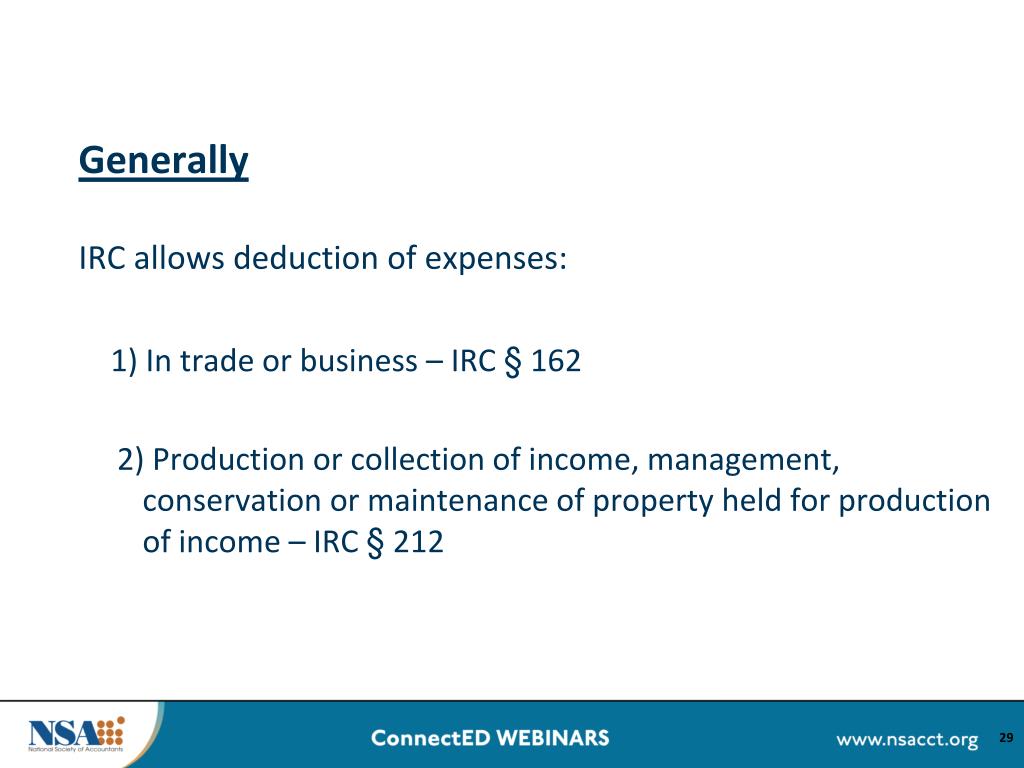
The legislative history is instructive of the types of expenses that Congress thought it was now denying in the name of simplicity. The Senate Amendment, followed by the Conference Agreement, was far broader and expressly suspended all miscellaneous itemized deductions subject to the two-percent floor.
#Irc 212 code
The scant legislative history suggests that House bill was again trying to “simplify” the tax code by expressly denying (at least until 2026) two specific categories of miscellaneous itemized expenses in particular: That legislation enacted new paragraph (g) of IRC 67 that provides in its entity: “Notwithstanding subsection (a), no miscellaneous itemized deductions shall be allowed for any taxable year beginning after December 31, 2017, and before January 1, 2026.”

TCJA: If Only Congress Had the Benefit of the Above History LessonsĬomes now the so-called Tax Cuts and Jobs Act (TCJA) enacted on December 22, 2017. Thus, this reader of the section 67 regulations is left with the impression that all deductions allowed under IRC 212 were subject to the 2 percent floor but no expense incurred in a trade or business on IRC 162 would be limited except for employee business expenses. Paragraph (c) of that regulation explains that expenses covered under both IRC 162 and 212 should be properly allocated between the two sections on a reasonable basis. The same regulation, at paragraph -1T(b), defines miscellaneous itemized deduction largely by reiterating the definition in IRC 67(b). Indeed, temporary regulations issued in 1988 identified all IRC 212 expenses as subject to the 2 percent floor of IRC 67 but hardly touch upon trade or business deductions covered by IRC 162. The deductions authorized by either IRC 162 or 212 are not listed among the exceptions, making basically all deductions allowed by reason of those provisions subject to the 2 percent floor. IRC 67(b) defined “miscellaneous itemized deductions” as all “itemized deductions” except for certain specifically authorized exceptions. IRC 67(c) directed the Secretary (of the Treasury and thus the IRS) to extend the disallowance to expenses incurred by pass-through entities and the IRS did so in 1988 in Treas. The legislative history suggests that the logic for such limitation was to reduce record keeping burdens for nominal expenses and perceived confusion about precisely which expenses might be deductible. In the last major recodification of the Internal Revenue Code in 1986, Congress enacted IRC 67 to limit certain “miscellaneous itemized deductions,” to 2 percent of an individual taxpayer’s adjusted gross income (AGI).

1.212-1(b) elaborates the scope of 212 (2): “Similarly, ordinary and necessary expenses paid or incurred in the management, conservation, or maintenance of a building devoted to rental purposes are deductible notwithstanding that there is actually no income therefrom in the taxable year, and regardless of the manner in which or the purpose for which the property in question was acquired.” 1.212-1(o) explicitly provides that: “The provisions of section 212 are not intended in any way to disallow expenses which would otherwise be allowable under section 162 and the regulations thereunder.” The predecessor to section 212 was adopted in 1942 because courts were denying “ordinary and necessary” deductions for taxpayers who could not establish that they were engaged in a trade or business and therefore who were unable to satisfy that prerequisite for deducting expenses under IRC 162. (3) in connection with the determination, collection, or refund of any tax. (2) for the management, conservation, or maintenance of property held for the production of income or

(1) for the production or collection of income In the case of an individual, there shall be allowed as a deduction all the ordinary and necessary expenses paid or incurred during the taxable year. IRC Section 212 provides, in its entirety and unchanged since its inclusion in the 1954 Code:

Has Congress (Inadvertently?) Repealed All Deductions Previously Allowed Under IRC 212, Not Just the De Minimis Deductions Identified in the Legislative History and Most Summaries of the TCJA? If So, What Does That Mean for Shareholders and Real Estate Investors?


 0 kommentar(er)
0 kommentar(er)
